The Half-Distance
Murphy Reinschreiber used to expostulate about the lack of Half-Ironman distances. This is what we called them back then. Half Ironmans. Can’t really use that name anymore. Nor 70.3, unless we refer to Ironman 70.3, so, Half Distance it is.
Murphy was Paula Newby Fraser’s agent. “Why don’t we have more Half Ironman’s?” he’d ask, back in the early 90s. “Everybody likes this distance. We could have a series of these, and the Ironman pros would have something to race.”
Paula was and remains one of the sport’s great ultra athletes – maybe the best ever – but she was understandably mortal at 1 or 2 hour races. How many ultras can you race in a year? Five. Or more. That’s what Paula and Scott Tinley raced, and Ken Glah and the others. It’s amazing they had careers as long as they did. The Half Distance would have been perfect. It was perfect. But, it was rare.
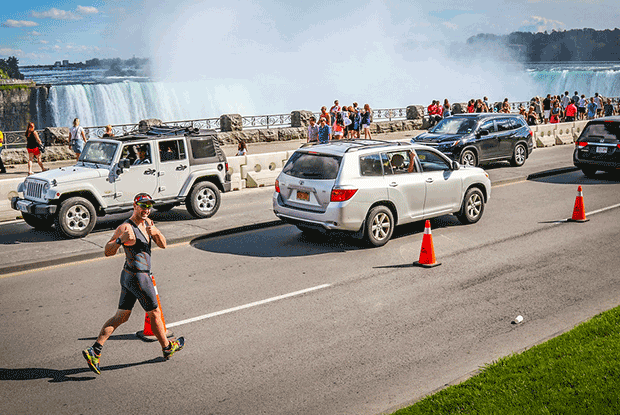
It may be hard for you to imagine a season with almost no Half Distance races, considering we now have 40 Ironman 70.3s in North America alone. But back then, in 1990, you could pretty much count them. Wildflower. St. Croix. Gulf Coast. Superfrog. Muncie. Then the list trails off pretty quickly. Eagleman, Timberman, Steelhead all sprung up later.
Odd, because the distance itself has been around. Murphy put one on himself, in 1981, and I raced it then or in ‘82. The Horny Toad. It was not exactly Half Distance, but pretty close. This was both the first prize money race and the first federation sanctioned race. Superfrog goes back further, to 1979, only a year after the very first Hawaiian Ironman.
Why did it take so long for this distance to catch on? I don’t know. But Murph was right. The distance is perfect, not only for pros – for whom 2 ultras sounds much better than 5 or 6 – but for the rest of us.
Is 2019 The Year of the Half?
Maybe. I think 70.3 Worlds in Nice, France may be one of the great multisport experiences in history. I’ll likely skip Kona this year and travel to this race instead. Imagine 3000 men and 3000 women racing on different weekend days, on those roads, in that sea, in that place. How did we get here?
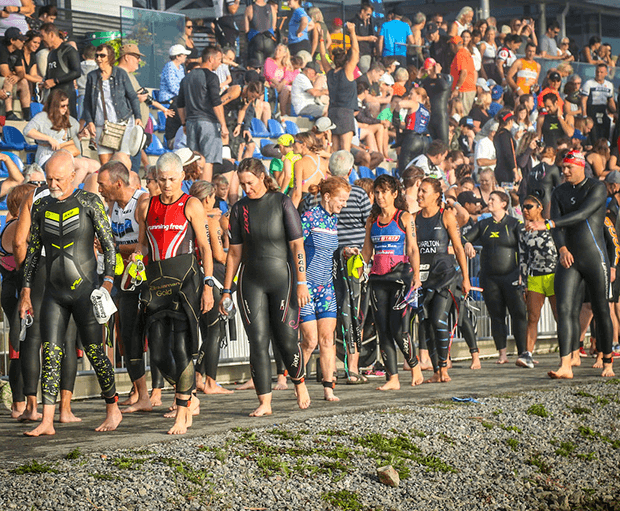
The two distances that dominated triathlon during the 1980s and early 90s were the Ironman and the Olympic. It wasn’t called Olympic back then, because this distance was established in 1982, 18 years before the first Olympic triathlon. It was the distance chosen by the USTS, aka the Bud Lite Triathlon Series, which established this as the typical weekender’s distance: 1.5km swim, 40km bike, and 10km run. We called this the International Distance back then (I don't remember why).
Is this the year when the Half finally emerges as the most coveted distance? I don’t know. We now host over 100 Half Distance races on our Slowtwitch North American Indy Race Calendar. By Indy we just mean not Ironman. Easy to find your 70.3 if you want. Less easy to find the rest of them. Even if you disregard the other series events that produce Half Distance races – HITS, Toughman, Challenge – we’ve got at least 85 on our calendar, which means: In North America Ironman produces 3 times more Halves than Fulls, and Indy Halves dwarf 70.3s.
What Do People Want?
When we poll our readers, you aren’t overwhelmingly in favor of racing a 70.3 over an Indy or vice versa. You're pretty evenly split on that. Nevertheless, most of you choose the 70.3. Why? One reason is safety. Polling suggests that contestants associate Ironman with safety. A bike course is more likely to be closed. Ironman debuted – with much sturm und drang among users – the streaming water start (the Cuisinstart makes plain how the thin veneer of civilization!).
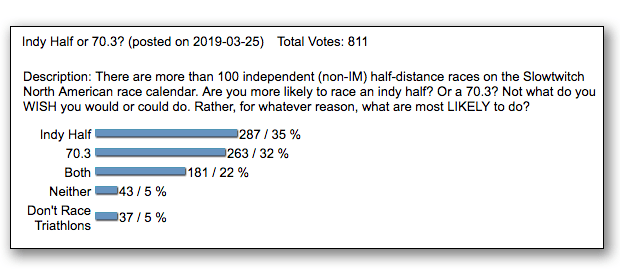
Beyond safety – and the fact that Ironman is the world’s preeminent producer of the mass athletic participation experience – contestants want a field size more closely associated with a 70.3. We’re polling this right now. The poll is just up; it’s very early. But so far I think you can see that a field size – sans relays – perhaps between 600 and 1600? Is that the sweet spot, where it’s not a zoo, but you don’t feel like you’re that guy in the last-human-on-planet-earth movie?
Why aren’t there more large Indy Halves?
Isn’t the lack of a lot of robust Indy Halves evidence that folks really just want to race 70.3 events? Well, there used to be large Indy Halves. Steelhead was every bit as big as an Indy race (when Tom Ziebart built it) as it is now as a 70.3. Milkman a few years ago, had 1,500 its first year and promptly sold to Ironman. Timberman, Mike Greer’s popular Buffalo Springs Half, and others became 70.3 events. If a half-dozen Indy Halves with registrations of 1,500 or more become 70.3s, then it’s inaccurate to assume that the Indy Half doesn’t have a ready audience!
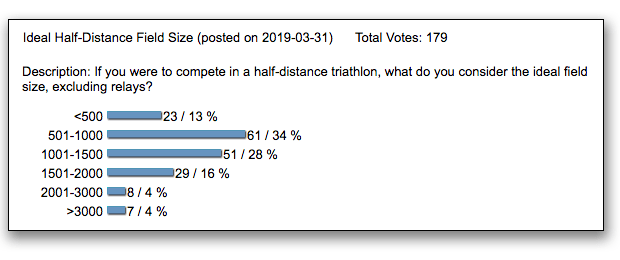
The Best Current Indy Halves:
Barrelman: The one fellow who’s bucked all the trends is John Salt up in Canada with his Barrelman. (The two images highest above are of this race; see Niagara Falls in the background?) Its numbers just keep edging up. It’s generally considered, in retrospect, that triathlon enjoyed a participation zenith in 1988, then a downturn, then ticked back up near the end of the century, and a new downturn began in around 2012 (we flattened in 2018, there are signs a bumpy uptick for 2019). But here are Barrelman’s numbers throughout our most recent downturn:
2014 – 725
2015 – 750
2016 – 800
2017 – 1,100 (in a marketing partnership with Rev3)
2018 – 900
2019 – projected 1,100 or more based on current registration.
These are just about all individuals racing the half. Perhaps 25 teams – 75 total participants – are relays.
Is this uptick just because the Half Distance is trending? No, according to John. Not in Canada. “I think the focus is shifting to shorter distance races.” Still, he says Barrelman is growing a bit faster than the other – shorter – races that he produces. His increases in this race are coming from the U.S. “We typically see 800 Canadian athletes,” and those 300 U.S. competitors are up from fewer than 100 back in the earlier part of the decade. John is confident his event is at least on par, product quality wise, with a 70.3, which he feels an Indy Half needs to be in order to prevail.
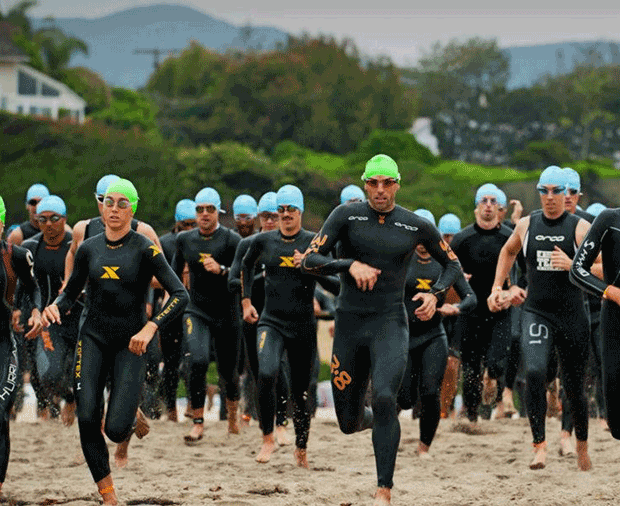
Malibu: Hard to call this one of the best Indy Halves because it hasn’t happened yet. Motiv Sports is a mostly a run producer. But it’s into triathlons now and two if its marquee acquisitions were the Malibu Triathlon and Wildflower. Its Wildflower debut, last year, was a spectacular rebound. A true Phoenix. But Motiv canceled this year’s event and is throwing all in on the Nautica Malibu Triathlon, which adds a long course (Half Distance). Why? I’ll write about that as a standalone piece, because it’s freighted with more than I have room to write about now. Just, let me say this following about Motiv. I get the sense that it’s got one eye on what Sir Richard Branson has in mind with Virgin Sport; the other eye on Ironman, i.e., Motiv – I think – is hoping to meet or exceed the product each delivers. I'm talking about Motiv's new Half because geography and cultural vibe injected with scale produces an immersive athletic experience, and has a chance to become a standalone monument. (The last 2 images here are of the Nautica Malibu Tri).
The Brutal Business of Halves: A strong Half Distance race is a coveted event, which makes it a tough business. Timberman was purchased by Ironman, transitioned to 70.3, then canceled. But that’s not the whole story; it was a casualty of war, and for every battle lost a number of others were won. It’s hard to argue that Rev3’s Quassy and Maine events; Eagleman – which really was saved by Ironman – and Superfrog aren’t better off as 70.3s. Ironman adds, subtracts, adds, subtracts: Canceled 70.3s include Timberman, Mooseman , Miami, Boise, Raleigh, Austin, Lake Stephens, Kansas, Syracuse, Branson, Providence. But the 70.3s that remain all fit Ironman’s business model, i.e., they’re all successes.
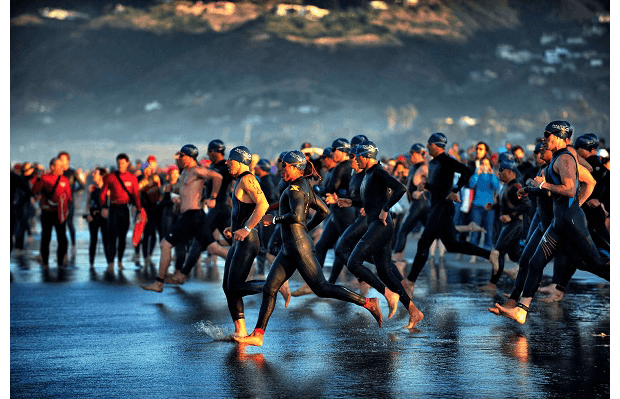
Is it possible for a race to be a popular Indy without it becoming a 70.3? Could some of these canceled 70.3 venues – which started as Indies! – be resuscitated as Indies? I understand there’s a new Indy Half in Raleigh. We’ll see. Pumpkinman and the Patriot Half are well respected Indy Halves that remain Indy.
Licensed Halves: In between are 70.3s that are “Indy” in their ownership but adhere to the imperatives laid out by Ironman. The only one I know that remains in the U.S. is 70.3 Atlantic City and here is the one example of a race org that might, maybe be better than Ironman’s own. Stephen Del Monte is triathlon gold right now. Equally compelling are the 70.3s produced by ASDEPORTE in Mexico, in Campeche, Monterrey, Cozumel and Los Cabos.
While contemplating these Half Distance events I contacted Murphy Reinschreiber, who I hadn’t spoken with in some time. He's part of the executive team that just concluded a successful edition of the L.A. Marathon. He talked about that event's owner, Frank McCourt, and how blessed a local community when the Frank McCourts and Sir Richard Bransons own its cultural institutions. Murph and I agreed that this is what makes these events singular and successful. John Salt, according to Barrelman race announcer Steve Fleck, “stands just past the finish line and shakes the hand of every person that crosses, “looks them in the eyes and says, ‘Congratulations. Thanks for racing with us today.’”
We probably have too many Indy Halves. We don't need 110 of them on this continent. We need more than 30, fewer than 60, each with 500 to 2,000 entrants, each produced by a carer. A curator. A custodian of the race experience. A John Salt. A Valerie Silk. We are mature enough to want Ironman to brutally rise and cull the field of its 70.3s; we are mature enough to make the case to local cities, counties and CVBs for well-populated Indy Halves. This distance did not figure much during triathlons first 20 years. It may soon become the most important.


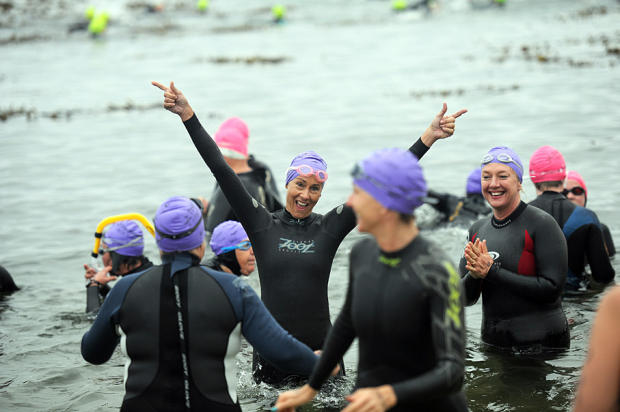
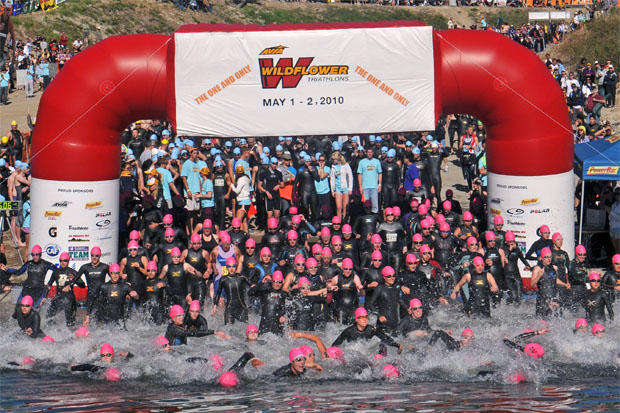
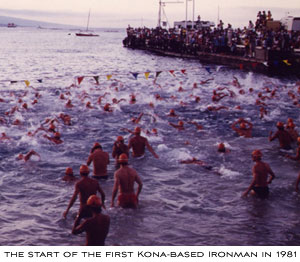
Start the discussion at forum.slowtwitch.com